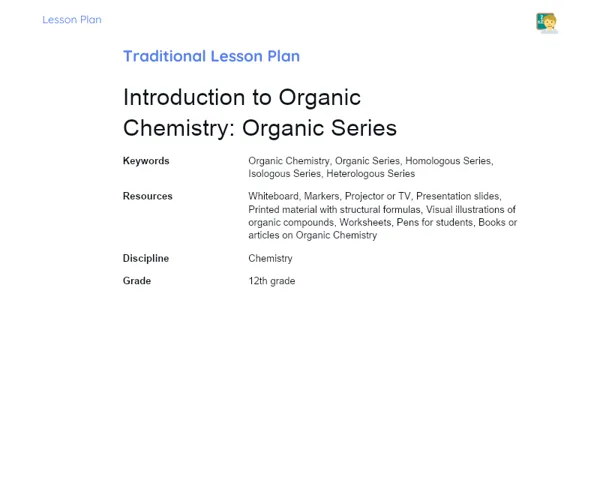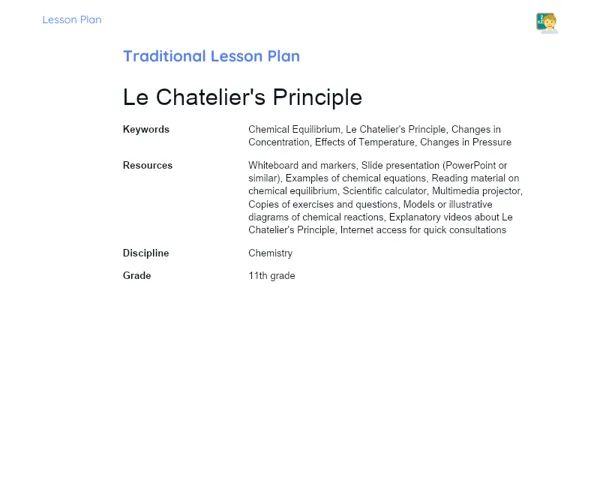Lesson Plan Teknis | Thermochemistry: Hess's Law
| Palavras Chave | Hess's Law, Thermochemistry, Enthalpy, Formation Enthalpy, Chemical Reactions, Enthalpy Calculation, Chemical Simulation, Industrial Applications, Pharmaceutical, Petrochemical, Energy Efficiency, Industrial Processes |
| Materiais Necessários | Computers with internet access, Chemical simulation software (e.g., PhET Interactive Simulations), Projector or TV for showing videos, Short video on the application of Hess's Law (3-5 minutes), Note-taking materials (paper, pen, etc.) |
Objective
Duration: (10 - 15 minutes)
At this stage of the lesson plan, the aim is to ensure that students grasp the objectives and appreciate the significance of learning Hess's Law for computing enthalpies of chemical reactions. Developing these practical skills is vital to equip students for real-world challenges in the job landscape, where thermochemistry plays a role in sectors like pharmaceuticals, petrochemicals, and materials. A solid theoretical and practical base is also essential for students looking to build careers in scientific and engineering fields.
Objective Utama:
1. Explain Hess's Law and its significance in Thermochemistry.
2. Demonstrate the application of Hess's Law for calculating the enthalpy of a chemical reaction.
Objective Sampingan:
- Reinforce the concept of formation enthalpy.
- Present practical industry examples of how Hess's Law is employed in the job market.
Introduction
Duration: (10 - 15 minutes)
This stage of the lesson plan aims to ensure that students fully understand the objectives of the lesson and the importance of Hess's Law for calculating enthalpies of chemical reactions. It is vital for students to develop practical skills that prepare them for the realities of the job market, where thermochemistry is relevant across various industries including pharmaceuticals, petrochemicals, and materials. Furthermore, this blending of theory and practical application is crucial for students who aspire to enter scientific and engineering professions.
Curiosities and Market Connection
💡 Curiosity: The principle behind Hess's Law was introduced by Swiss chemist Germain Henri Hess in 1840, and it has since become a crucial tool for engineers and scientists. 🏭 Market Application: For instance, in the petrochemical industry, Hess's Law assists in fine-tuning oil refining processes, enhancing energy efficiency and preserving resources. In the pharmaceutical sector, it is essential for synthesizing compounds where meticulous control over temperature and energy is required to ensure both efficacy and safety.
Contextualization
Hess's Law forms the foundation of Thermochemistry, an area of Chemistry that examines energy changes during chemical reactions. Imagine being equipped to forecast the amount of heat released or absorbed in a reaction; this capability is essential in industries like food production, fuels, and pharmaceuticals. Hess's Law makes this prediction possible by allowing us to calculate the enthalpy of complex reactions through simpler, known enthalpy reactions.
Initial Activity
🎥 Initial Activity: Start with a short video (3-5 minutes) showcasing the application of Hess's Law in an industrial context, like the synthesis of a medication. Following the video, ask the thought-provoking question: 'How do you think Hess's Law can improve energy efficiency in chemical industries?' Encourage students to discuss in pairs and share their insights with the class.
Development
Duration: (60 - 70 minutes)
This stage of the lesson plan is designed to provide students with a practical comprehension of Hess's Law, enabling them to develop technical and analytical skills pertinent to the job market. By involving students in simulation and problem-solving activities, they receive the chance to apply theoretical concepts in authentic contexts, nurturing substantial learning that prepares them for future hurdles.
Topics
1. Hess's Law: Definition and Significance
2. Formation Enthalpy
3. Application of Hess's Law to Calculate Enthalpies of Reactions
4. Industry Examples Demonstrating Hess's Law
Thoughts on the Subject
Prompt students to reflect on the impact of Hess's Law in both industrial and scientific processes. Ask: 'In what ways can the ability to predict the enthalpy of a reaction affect the efficiency and safety of industrial processes?' Encourage them to think about specific instances, such as drug manufacturing or oil refining, and discuss how knowledge of thermochemistry can give them a competitive edge in the job market.
Mini Challenge
Maker Challenge: Creating a Virtual Chemical Reaction
Students will engage with chemical simulation software (like PhET Interactive Simulations or an available alternative) to model a series of chemical reactions and directly apply Hess's Law to determine the enthalpy of the overall reaction.
1. Split the class into groups of 3-4 students.
2. Provide each group with access to the chemical simulation software.
3. Encourage them to select a complex chemical reaction for simulation.
4. Guide them to identify intermediate reactions with known enthalpies and utilize Hess's Law to compute the enthalpy of the overall reaction.
5. Encourage each group to document every step of the process, including chemical equations and enthalpy calculations.
6. After the simulation, have each group prepare a brief presentation (3-5 minutes) to share the process they undertook and their findings.
Apply Hess's Law within a practical and technological framework, enhancing modeling and simulation skills that are highly sought-after in the job market.
**Duration: (35 - 45 minutes)
Evaluation Exercises
1. Calculate the overall reaction enthalpy using the following intermediate reactions and their respective enthalpies:
2. Reaction 1: A + B → C, ΔH = -100 kJ/mol
3. Reaction 2: C → D + E, ΔH = +50 kJ/mol
4. Reaction 3: E + F → G, ΔH = -30 kJ/mol
5. Determine the enthalpy for the reaction: A + B + F → D + G
6. Discuss how Hess's Law can be applied to optimize a specific industrial production process (choose an industry example, for instance, pharmaceuticals or petrochemicals).
Conclusion
Duration: (10 - 15 minutes)
The objective of this final stage of the lesson plan is to solidify the knowledge gained by students, fostering critical thinking about the practical applications of Hess's Law. By summarizing the content and encouraging discussion, the aim is to ensure that students recognize the importance of the topic for their career prospects and feel prepared to translate these skills into real-world contexts.
Discussion
Foster a discussion with students on the various applications of Hess's Law in industrial and scientific scenarios. Encourage them to share experiences from the maker challenge and fixation exercises, touching on challenges faced and innovative solutions generated. Ask: 'What were the key takeaways from applying Hess's Law in the simulation? How do you envision this tool being beneficial in your future careers?'
Summary
Recap the key content discussed, underscoring the definition of Hess's Law, the significance of formation enthalpy, and the practical usage of Hess's Law for calculating enthalpies of reactions. Reinforce the connection between the theoretical knowledge gained and its applications in the job market, especially within the pharmaceutical and petrochemical fields.
Closing
Elaborate on how the lesson interconnected theory, practice, and the applications of Hess's Law. Stress the significance of learning thermochemistry in ensuring the efficiency and safety of industrial processes. Conclude by emphasizing that the ability to calculate the enthalpy of chemical reactions is a valuable and applicable skill across various professional arenas, from academic research to industry.



